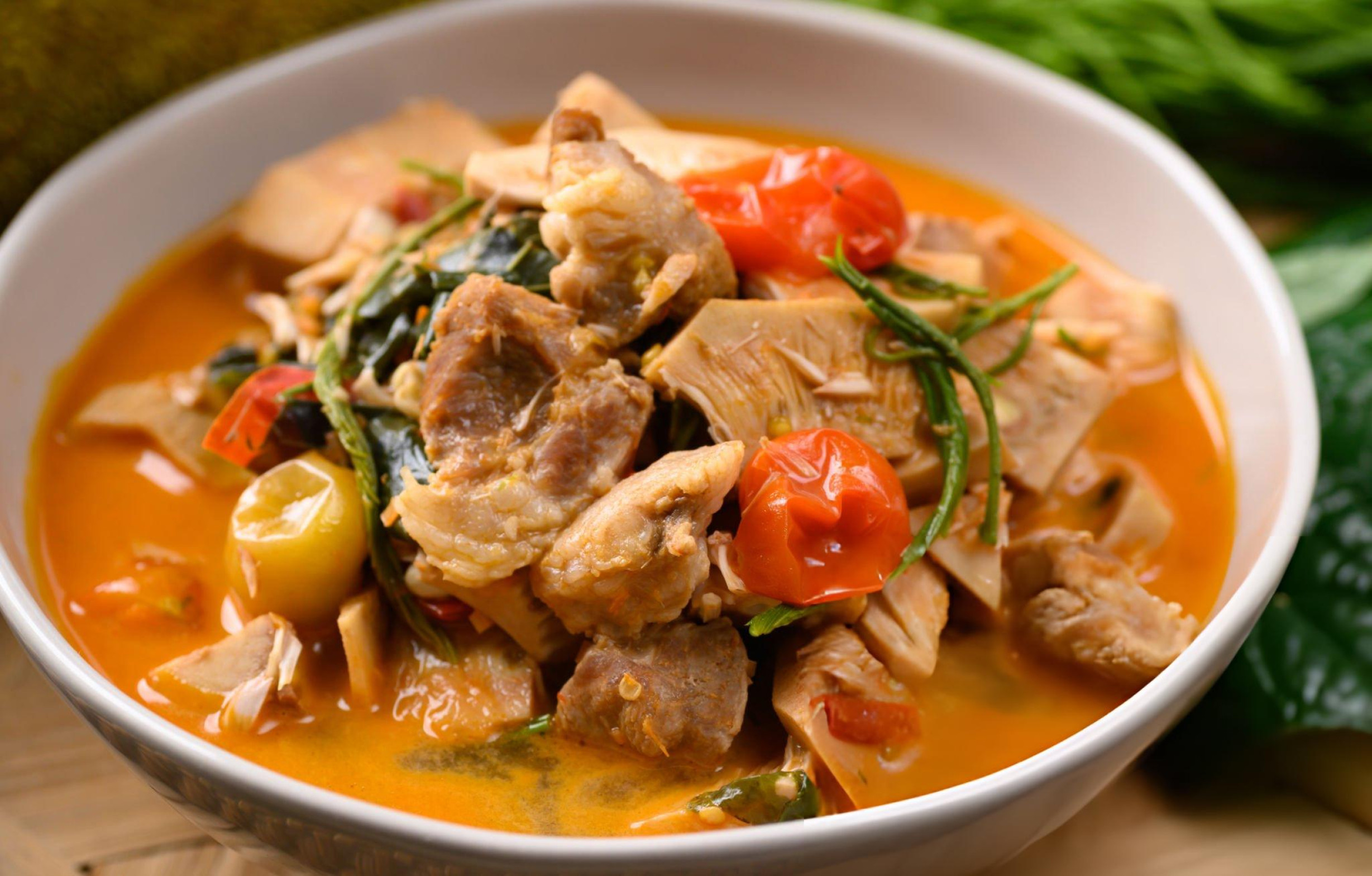
Jackfruit Curry with Beef Spare Ribs Recipe
This jackfruit curry with tender beef spare ribs is a rich and aromatic dish, bursting with savory flavors, soft jackfruit, and fresh greens in every spoonful. Perfectly paired with jasmine rice, it’s a hearty meal that satisfies every craving.
Print
Pin
Servings: 4
Ingredients
Curry Paste
- 6 cloves garlic
- ½ cup chopped shallots
- 0.5 oz dried red chilies see note 1
- 2-3 teaspoons fermented shrimp paste see note 2
Jackfruit Curry
- 1 lb beef spare ribs cut Asian style (see note 3)
- 4 cups water
- 1 can young green jackfruit in brine 20 ounces/550 mL; drained weight: 300g/10.5 oz
- 1 cup halved cherry tomatoes
- 1-2 tablespoons fish sauce
- 20 wild betel leaves or another leafy green cut into 1-inch strips (see note 4)
- 1 cup Cha-om climbing wattle, see note 5
- Jasmine rice for serving
Instructions
- Begin by placing the beef spare ribs in a large pot. Pour in the water and add 1 tablespoon of fish sauce. Bring the mixture to a rolling simmer over high heat, then reduce to a gentle simmer to allow the ribs to cook evenly.
- While the ribs are simmering, prepare the jackfruit. Drain the can and rinse the jackfruit thoroughly under cold water. Cut it into smaller, bite-sized chunks and add them to the pot alongside the ribs.
- While the ribs and jackfruit cook, prepare the curry paste. Begin by grinding the dried chilies into a fine powder using a spice grinder; set aside. In a mortar and pestle, pound the garlic and chopped shallots into a coarse paste. Once the garlic and shallots release their juices and become slightly mushy, incorporate the ground chilies. Continue to pound until the mixture forms a rough paste. Finally, add the fermented shrimp paste, ensuring it is well combined. The paste should be cohesive but doesn’t need to be perfectly smooth.
- As the broth simmers, skim off any scum or impurities that rise to the surface to keep the broth clear and flavorful. Stir in the freshly prepared curry paste and allow the flavors to meld as the beef continues to cook. Let it simmer gently for 2 to 3 hours, or until the ribs are fall-off-the-bone tender. The cooking time may vary depending on the thickness of the meat on the ribs.
- Once the ribs are tender, add the halved cherry tomatoes and all the leafy greens, including the betel leaves and Cha-om. Stir gently to submerge them in the broth, letting the greens wilt and the tomatoes soften slightly, which should take about 1-2 minutes. If needed, add a bit more water, but ensure the liquid level remains just enough to keep everything submerged without being overly watery.
- Taste the broth and adjust the seasoning to your liking. Add more fish sauce for a salty, umami-rich kick or an additional touch of shrimp paste for more depth of flavor. If the broth leans too salty, a pinch of sugar will balance the flavors beautifully.
- Serve the jackfruit curry piping hot over steamed jasmine rice, allowing the flavors to shine in every bite. Enjoy the tender beef ribs, soft jackfruit, and rich, aromatic broth that bring this dish to life.
Notes
1. Choosing Dried Red Chilies:
- Use any type of dried red chilies depending on your desired spiciness level.
- For a mild curry, opt for large chilies like guajillo or puya peppers.
- For a spicier curry, use smaller chilies such as dried Thai chilies.
- Combine both types for a balanced heat level.
- To reduce the heat, do not decrease the quantity of chilies. Instead, remove the seeds and pith.
- The amount listed is the minimum required, but you can add more for extra flavor.
- Start with 2 teaspoons of shrimp paste for a subtle umami flavor.
- If you prefer a stronger “funk,” gradually add more.
- As an alternative to shrimp paste, use 1-2 tablespoons of miso paste for a milder, earthy flavor.
- Look for spare ribs at Asian markets, where they are often cut into short pieces.
- The ribs may already be separated into individual pieces or come as long strips that you’ll need to cut yourself.
- Full-sized ribs can also be used, but they may be slightly more cumbersome to eat.
- Wild betel leaves (known as “la lot” in Vietnamese or “bai chaploo” in Thai) can often be found at Thai or Vietnamese markets.
- If unavailable, sturdy greens like Chinese broccoli or Swiss chard make excellent substitutes.
- Cha-om, a uniquely fragrant Thai vegetable, can sometimes be found fresh or frozen in Thai grocery stores.
- If Cha-om is unavailable, substitute with non-neutral-flavored greens like chrysanthemum greens (also called “tong ho” in Chinese). Use about 2 cups of these or any other flavorful greens available to you.